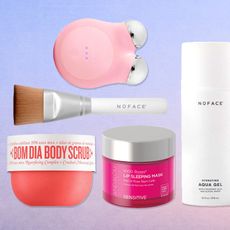How to Pick Retail Stocks and Invest In Your Favorite Brands
When it comes to fashion and beauty brands, it is our own income—our very own hard-earned dollars—that fuel these industries. Women could and should be profiting from the success of these multi-billion dollar companies through investing.


Celebrity news, beauty, fashion advice, and fascinating features, delivered straight to your inbox!
Thank you for signing up to . You will receive a verification email shortly.
There was a problem. Please refresh the page and try again.
Editor’s Note: Historically, when it comes to stock investing, women have been left out of the conversation. Earlier this year, I was covering Rihanna’s Savage x Fenty’s venture capital fundraise (to the tune of $125 million) and expansion into brick and mortar. The story involved a deep dive into the intimate apparel industry, including Rihanna’s competitors, like Victoria’s Secret and Aerie. While researching for analysts to interview, I couldn’t believe how much mainstream news still turned to men for insights on women's retail.
It’s infuriating. Because when it comes to fashion and beauty brands, (including lingerie!) it is our own income—our very own hard-earned dollars—that fuel these industries. We account for 85 percent of all consumer purchasing decisions and $7 trillion in consumer and business spending. According to data from SmartAsset and the Bureau of Labor Statistics, women ages 25-35 spent about 42 percent more than millennial men on apparel and personal care.
We are the experts. Further, we could and should be profiting from the success of these multi-billion dollar companies through investing.
For that Rihanna story, I interviewed a women-led investment research team. For this story, I asked Jane Hali (opens in new tab), founder of Jane Hali & Associates, to teach us how to pick the right stocks. With the disruption of the discretionary retail landscape, Hali has developed her own trademarked proprietary method to analyze the health of brands today, which investors can use in addition to reading the company’s earnings statement. While you should explore investing in other industries that appeal to you, be it tech or clean energy, we at Marie Claire are aptly using fashion and beauty as starting examples. As Hali’s top money mantra goes: “Invest in what you know.”
How to Pick the Right Stocks
Investing is critical to your future wealth. Your total investment should be a well-rounded portfolio including stocks, bonds, and more. There are many different types of investment portfolios, as some are built into mutual funds, like 401(k)s, IRAs, and more. Consider working with a fiduciary financial advisor who can guide you through building your portfolio.
In this article, we will discuss public stocks (or equities), which you can purchase through a brokerage or financial advisory firm. Stocks tend to be riskier, yet can potentially deliver higher returns. Meanwhile, mutual funds tend to offer more stability. But don’t let the word “risk” deter you from gaining long-term, potential returns. Again, work with a financial advisor and assess your financial status to determine the right mix for you.
Note that the following stock examples are based on research from JHA, and used here to give concrete advice and action steps for stock investing. It is up to you to conduct your own due diligence before purchasing a stock. Whether you work with an advisor or want to start investing in individual stocks on your own, develop a systematic form of analysis to determine whether a stock will make a good addition to your portfolio.
When it comes to fashion and beauty brands, (including lingerie!) it is our own income—our very own hard-earned dollars–that fuel these industries.
Invest in What You Know
We have a wealth of knowledge just by shopping in person and online. Which retailers and brands have our loyalty? Check various social circles and age groups—what’s everyone talking about within these niche markets that the mainstream media has not yet picked up on? Which brands are building organic followings and communities?
Retailers and Brands represent the “Consumer Discretionary” area of investing, where we can touch and feel the products and have true shopping experiences. (There are many areas for investing including Healthcare, Financials and Technology.) As shoppers, we already have most of the tools we need to invest for the long term. The stock price will go up and down day to day, but long-term investing is key if you believe the company is on the right path.

1. The Product
Do the products have longevity? Assess whether the company is on trend in terms of customer preferences, and whether the brand has a compelling story, and most importantly, make sure it has staying power. How do they stack up against the competition? We are now in an inflationary period; however, the merchandise should be priced appropriately.
For example, when you cruise the aisles of Ulta Beauty (ULTA U.S.: Nasdaq), you could be thinking about whether it's a good stock or not, as you browse for your favorite cosmetics. How does the retail chain measure up to the questions above?
2. The People
Leadership: Who is the founder and/or CEO? Has the company hired new, promising leaders to its management or board? Visit the “Press Releases” section of the company website to stay current. You can also check Google News, the Wall Street Journal, or any business news site to learn about its CEO, latest hires, innovative launches or expansion plans. Beware if you notice a series of troubling headlines, like mass layoffs, poor earnings statements or any controversies. But remember, think long-term and do not be reactive to every news alert.
Social Media/Influencers: Does the company engage you on social media? Check its follower count on Instagram, TikTok, etc, and whether its selected influencers are on brand.
For example, Nike (NKE U.S.: NYSE) as of this writing has:
• 220 million Instagram followers.
• 2.4 million TikTok followers
• Nike Women has 7.2 million Instagram followers.
• Nike Sportswear has 7.9M Instagram followers.
• Nike Running has 5.6M Instagram followers.
The company constantly updates its roster of influencers and high-profile ambassadors, striving for a wide range of athletes and celebrities to appeal to its diverse audience. From its mini-documentary with 2021 U.S. Open champion Emma Raducanu to its “Hot Girl Coach” dance sport campaign with Megan Thee Stallion, brands new and old can learn from Nike’s robust influencer marketing strategy.
While a Pace University study has found that social media popularity can predict daily stock prices, this is just one way to check the pulse of a company–and should not be the single determining factor.
3. Consumer Experience
In-Store: Does the store offer an engaging shopping experience? Are you happy to be there, and does the store and staff make it easy to shop? Does the store use tech to further engage you? If the stores are a constant mess with rude employees, that’s a red flag.
For example, Nordstrom (NYSE:JWN) is known for its pop-up concepts, Pop-In@Nordstrom. Its latest iteration is titled “Sports!” featuring in-season and on-trend apparel, footwear and accessories for golf, tennis, training, and cycling inspired by nostalgic sportswear. The department chain comes up with fresh themes every few months, giving shoppers a reason to return.
Online: In addition to the aesthetic and layout of the e-commerce, click-through and test the user experience. Can you filter and easily find what you are looking for? At JHA, we believe live streaming events/selling on websites is the future.
For example, Revolve (RVLV: NYSE) offers an excellent digital experience, exhibiting a strong merchandising strategy across categories. The merchandised stories, as of this writing, includes a Festival shop, Swimwear Shop, Special Occasion Dresses, Festival Beauty, Spring Shop and Wedding Shop.

4. Multi-Channel
It’s important to note that good marketing and consumer experience matter, especially for fashion and beauty brands. But these are just one of many factors for assessing investment opportunities. Remember that a brand with marketing prowess can be struggling behind the scenes. Meanwhile, a company with little to no pizazz or buzz can be financially sound. For example, Walmart (WMT: NYSE) and Tractor Supply Co. (TSCO: Nasdaq) might not have retail experiences in the same league as Ulta or Revolve, but their stocks tend to do well.
Check whether the company successfully marries the in-store and online experience. Can you buy and return in-store or online? Does the company have a full-service shopping app for a seamless mobile experience?
For example, the Levi Strauss & Co. (LEVI: NYSE) app has curated content and app-exclusive products. Those same products are also available on the website.
Here are more ways to assess whether a company is leveraging a multi-channel strategy:
- Can you buy online and pick up in-store?
- Does the brand or retailer offer different payment plans, i.e., Apple Pay, PayPal or offer payments over time i.e. Klarna, Afterpay?
- Do they offer curbside pickup?
- Does the website offer Fit Technology?
5. ESG: Environmental, Social and Corporate Governance
Millennial and Gen Z consumers are increasingly buying from companies that are making our world a better place. An attention to good environmental and social policies (such as inclusion and fair labor) can no longer be an afterthought. These values have become key to brand survival.
Speaking of inclusion, look at how the companies support diverse communities. Consider investing in women-led organizations, with diverse workforces and management teams. As you shop your favorite retailers, be it for fashion or beauty, keep all these points in mind.
6. The Results
Last but not least, the numbers matter most. If you really want to feel confident about placing your first buy order, check out Kiplinger's breakdown of the important figures you'll need to understand when investing in stocks. The most important metrics skilled investors use to value a company are fundamental metrics like sales, costs, revenue and earnings. You can find all this information by reviewing historical stock performance and recent earnings statements. Here’s how:
I’d advise any beginner to do thorough stock research through a diverse set of credible sources, such as financial news outlets, stock research platforms, a fiduciary financial advisor, and, of course, your very own judgement, which you can hone over time.

Jane Hali launched Jane Hali & Associates (JHA) in 2015. Jane has over 30 years of diverse experience in retail, wholesale and consulting to the investment community, Jane’s international experience includes CMO, Chief Merchandising Officer, at Rodier Paris USA where she led the buying and merchandising for the U.S. chain of stores. She was also a C-level executive at Planet Retail Investment Research.
- Tanya Benedicto Klich Senior Editor
-
 The Best August Beauty Launches, According to Marie Claire Editors
The Best August Beauty Launches, According to Marie Claire EditorsSo. Many. New. Products.
By Samantha Holender
-
 How This Royal Lived Incognito for 13 Years
How This Royal Lived Incognito for 13 YearsThis is kinda crazy.
By Iris Goldsztajn
-
 Prince Harry May Well Come Back to the U.K. "In a New Role" When Charles Is King, His Former Protection Officer Says
Prince Harry May Well Come Back to the U.K. "In a New Role" When Charles Is King, His Former Protection Officer SaysCould you see this happening?
By Iris Goldsztajn


